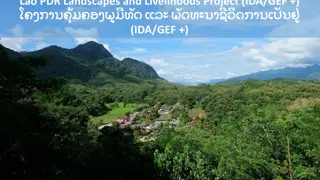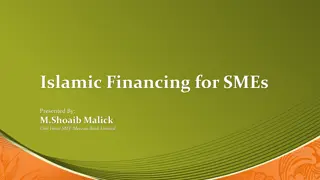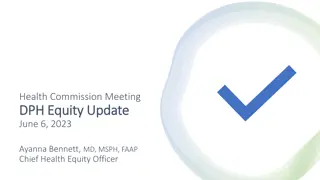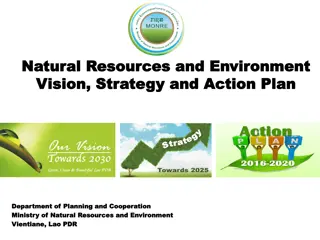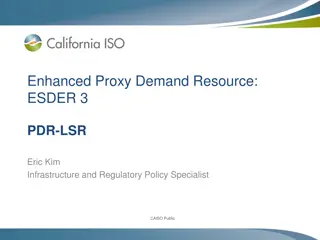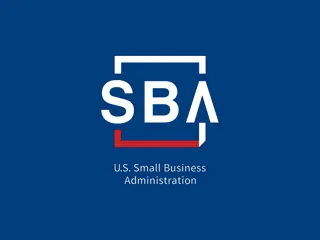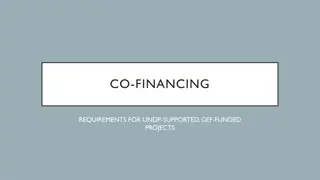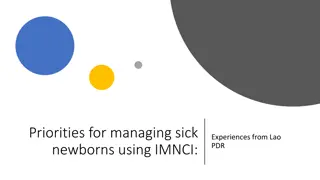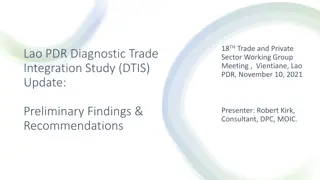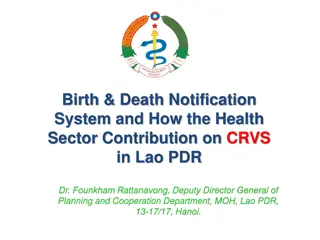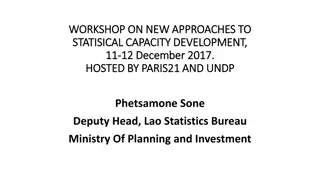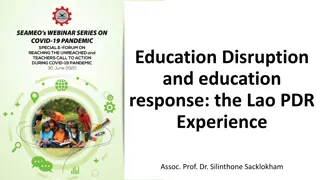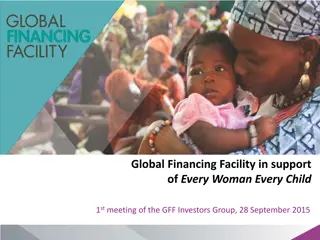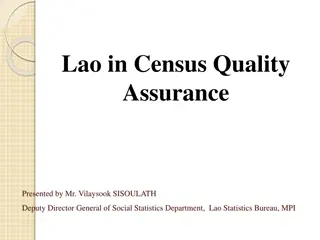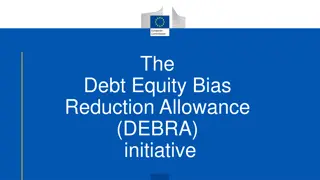Equity in Development Partners Support on Health Financing in Lao PDR P4H Meeting
The meeting focuses on addressing health indicators, inequities, and health financing challenges in Lao PDR. It analyzes the background of health indicators, inequities by socio-economic status and ethnic groups, and the current health financing situation in the country. The discussion delves into strategies for improving health financing, increasing investment in public health, and enhancing social health protection to achieve Universal Health Coverage by 2025. Development partners play a crucial role in supporting various health financing schemes and modalities to strengthen the health system.
Download Presentation

Please find below an Image/Link to download the presentation.
The content on the website is provided AS IS for your information and personal use only. It may not be sold, licensed, or shared on other websites without obtaining consent from the author. Download presentation by click this link. If you encounter any issues during the download, it is possible that the publisher has removed the file from their server.
E N D
Presentation Transcript
Equity in Development Partners support on health financing in Lao PDR P4H Meeting Content: 1. Background 2. DPs on health financing 3. Equity in DPs support for health financing 4. Discussion 1
1. Background Health indicators Poor health indicators . with constant improvement 2
1. Background Inequity By socio-economic status By ethnic group 3
1. Background Health Financing in Lao PDR ~30$/cap 50% in OOP Very low domestic funding but high increase in past 2years (0.5%=>1% GDP; 3%=>6-9% Domestic GGE) * High External support for public health: 25-35% Low social health protection coverage (24%*) with challenges to cover the informal sector and even to enforce enrolment for private employees Context: Decentralization; Financial crisis since 2013, Increasing inequities and corruption Limited service delivery/performance/quality of public health system 4
1. Background HF Policy in Lao PDR Health Sector Reform Health Financing Strategy Phase 1(2013- 2015): To achieve MDG targets Phase 2 (2016-2020): To improve access to basic health care and financial protection Phase 3 (2021 2025): To reach UHC 1. Increase investment in public health, esp. from domestic source 2. Increase allocation to PHC at district level, focus on the poor 3. Increase Social Health Protection 4. Strengthen capacity in health financing 5 Mainly pushed by Government and DPs agenda (Dvpt Correct / Not exclusive)
2. DPs in HF DPs on health financing Many DPs (multilateral, bilateral, INGOs) Specific focus: comprehensive PHC support, sub-sector support, Socio-health protection, NHA/Costing.. Various coverage: national, province-wide, districts Various schemes: supply funding, free national programs, SHI, HEF, Free MNCH, RBF for Quality Preventive, CCT Various modalities: Budget support (EC-WB), Program (ADB), MOH projects (WB, WHO, Unicef), TA (WHO, ILO), Provincial support (Luxemburg), Projects (NGOs) Concentrated technical support mainly at central level No match between HF DP support and the very limited technicians on HF/SHP (~50% in training/meetings) 6
2. DPs in HF Health Financing specific What * Where How Supply Focus Selective focus Social Health Protect. Policy PFP PFQ Poor Infor CBHI Infor CHE PHC subs Prog Nat. Free MAT Free CU5 Formal SHI TA HEF MOH Country Program X X X X X X X x X ADB North=> all? Program X X X WB X X South=> all? Project/Progr x X x Luxemburg Provinces Province X X X x ILO/WHO District TA+ Project X X X KOFIH/WHO Province TA+ Project X EC/WHO District BS+ Project x x X JICA Province TA + Project X Un fpa/icef Country/Pro Nat. Progr X X GF, USAID.. Country Nat. Progr. X GAVI Districts Project X x x SCI/CARE.. Province Projects X 7 SRC Province Projects TA X x x X x X
2. DPs in HF DPs collaboration Improving collaboration / coordination mechanisms among Gov t-DPs and within DPs Official Sector Wide Coordination (Working Groups, Technical WG, Task Forces) led by Gov t/WHO/JICA; New DPs group INGO network (CCM GF) Joint projects: ILO/WHO, EC/WHO, UN/Luxbg Sub-contracts: MOH/WB-SRC Regular unofficial collaboration Joint monitoring programs (?): ADB-WB No P4H 8
3. Equity DPs support Equity in DPs support (health financing) Various results (no robust assessment): Supply: Continuous support to ensure PHC/MNCH service delivery at district level strongly increases MNCH indicators, health systems performance/ownership (SCI); ensure first funding of routine immunization, nutrients is fundamental (Unicef) HEF: When managed/monitored proactively with clear targeting (HH poor card or village targeting), HEF for poor can increase access to curative services for the poor (2-3x increase, poor use more than non-poor, distance barrier reduced*) but less for delivery, not for preventive services, nor guaranty of quality; Village targeting increases very significantly the utilization of curative services (but also unnecessary utilization) and requires control of overuse for OPD/observations prone to cheating (MOH/SRC-WB) HEF in a passive government led setting under govt list of HH targeting without card can be expanded fast, well integrated in government system and be a cheap pro-poor subsidy to local facilities. But it may not be enough to really prevent catastrophic health expenditure (MOH/ADB, MOH/Govt) 9
3. Equity DPs support Equity in DPs support (health financing) Various results (no robust assessment): Free Maternity : slower uptake than for curative services; money is not the main barrier for delivery; supply factors more important (presence of midwife, trust, perceived quality, language, traditions); unequal results poor (20%) vs non-poor (40%) capture of funds by the non- poor; bypassing of lower level (MOH-WB, MOH-WHO) * => From universalism to targeting? (free for all only at district level + referrals; in towns free only for poor; Food/Transport only for poor) Free CU5: seem to boost consultations for non-poor and poor; slow increase of admissions/surgeries (MOH-SRC/WB) CBHI: failure or stagnation (collection issue, small pools, adverse selection, risk on provider, underservicing, vicious circle) ; 50% subsidies about to be tested by MOH-ILO/WHO in one pilot district Formal SHI: fast extension to civil servants, low enrolment of private companies (poor enforcement), big push/rationale for merging but risk of unintended consequences (merged reserve, pension), providers and insured not fully on board 10
4. Discussion What HF interventions? 1. In context of Laos, to improve equity in health, what is the right mix & acceptable trade-off in terms of focus on: Improve the health service delivery supply at local level (functioning PHC) Improve access to the poor (HEF) Also subsidize for non-poor/catastrophic expenditure Improve access to specific priorities (Free MNCH, pay for preventive services, etc) Improve the quality of services (PBF-Pay for Quality) 2. No agreement on Universalism at local level or Targeting 3. Sum of parallel strategies can be detrimental (absorption, HR, perverse effects, competition, complexification ). 4. Too advanced HF strategies for the level of service delivery? 11
4. Discussion How? The how to provide support may have as much importance as the what ? Institutionalization: Budget support vs Program vs Project Predictability, timeliness, flexibility, simplicity and accountability of funding Cost of change in approaches Subsidy + proximity technical/management support 12
4. Discussion DP Collaboration Optimal DP Collaboration? Real move by DPs towards real joint collaboration in health funded interventions (e.g. WB-ADB, DPs informal meetings..) Still key differences on philosophic, process, technical/internal DP constraints Time consuming collaboration/info sharing with still limited operational synergies Competing for limited HR, time and government funds ~ DPs agreement on what but not yet on the priority entry points, the steps and how . No clear messages to MOH & MOF (Policy = sum of DPs priorities and Government agenda) 13
Health Financing * Decentralization Financial crisis since 2013 15
Social Health Protection Coverage * Excluding Police/military 17
HEF * HEF schemes By identification Method in Lao PDR March 2012 Mix Geographic/Individual MOH/HSSP Lux-Devp t LRC/SRC 6 districts 80,000 (%) Gov t List Poor MOH/HSDP (ADB) LRC 26 districts: 80,000 (9%) + Planned in 2012 34 Districts: 385,000 (33%) Controlled Participative Approach MOH/HSIP (WB-NT2-SRC) SRC/LRC 7 districts 29,000p (9%) Gov t Criteria s HEF collected MOH/HSSP Lux-Devpt PHO 12 dist. 11,000 p (3%) Geographic Targeting MOH/HSIP (WB-NT2-SRC) SRC/LRC 3 districts 59,000p (90%) Gov t List of Poor MOH (NT2) 10 districts 55,000 (9%) + 4 districts planned in 2012 18
Free MNCH Implementation by end 2013 * FMAT: 81 districts (110,290 PW = 59%) FCU5: 31 districts (167,612 CU5 = 20%) FMAT only FMAT + FCU5 19
HEF * IPD 2009 IPD 2013 Country avg excluding Vientiane whole pop.: 0.06 (incl HC Observ) 21
Free MNCH * FMNCH seems to improve MNCH coverage Continuous strong PHC/MNCH support without FMNCH seems to have an even greater impact : key MNCH indicators ~3 times better than the national average (SCI) but requires more time, more structural & integrated approach, less a quick fix 22
Free Maternity * Unequal results between Poor and Non-Poor. Non-Poor deliver ~2x more than Poor at public facilities (39% vs. 22%) Free Delivery for all logically profits more the Non-Poor 23




